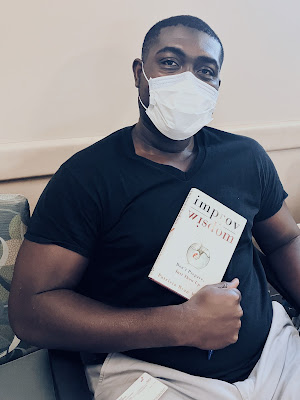Writing a Book!
I recently met a man named Tesa, who visited the ER department where I work in security. He was eager to write a book about himself after I handed him a card promoting my own books. When I asked him what he was reading, he mentioned a book by Patricia Ryan Madson titled Improvisation Wisdom. Another gentleman chimed in, saying that books about wisdom are always beneficial, and Tesa revealed that he actually found the book in the trash.
Foremost, as an author, you must have a passion for words as a melodic art form. You should be eager to showcase a unique story and develop your own writing style along the way.
Unless you can afford an autobiographer or ghostwriter, I would recommend that as a first choice. They are experts at guiding you in starting your story, and you can find ghostwriters on Fiverr.
If you have a personal diary, try to remember as many memorable moments as you can—whether happy, tragic, or sad. Write down whatever stands out in your memory first; it may lead you back to things you thought you had forgotten and need to revisit. Each journal should have a title, and keep as many paper or digital diaries as you need until you run out of fascinating experiences to write about.
Blogging is also a great way to write about yourself. If you’re willing to share publicly, just be careful—make sure you have some form of cyber protection and consider consulting cyber attorneys.
As I mentioned to Tesa, when I write my science fiction stories, I start with a plot: what the story is about. Second, I build my primary characters, then my secondary characters; tertiary characters often come to me as I write. Third, I outline the chapters—let’s say ten chapters for example—and provide a short synopsis for each one. Then, brainstorm for each chapter, aiming for ten paragraphs along with some dialogue. Don’t worry about grammar or spelling at this stage.
Next, do some self-editing and remove anything unnecessary or add anything you think might enhance your story. AI can be a great resource for self-editing, like ChatGPT; just ask it to check one paragraph at a time (type “Grammar this:” before your text). I wouldn’t recommend submitting your entire book at once for editing—focus on one paragraph or sentence at a time.
Finally, consider hiring a professional editor online, such as through Fiverr. If you want to self-publish your book, search on YouTube for guidance on how to publish on Amazon KDP. Good luck, Tesa, with your first book! Additionally, before you publish, you’ll need a book typographer and a book cover designer, which you can also find on Fiverr.
From ChatGPT
1. Define Your Purpose
Before you start writing, take a moment to reflect on why you want to share your story. What do you hope to achieve with your autobiography? Are you aiming to inspire others, document your experiences for future generations, or simply reflect on your journey for yourself? Understanding your purpose will help guide your writing process and provide a framework for the themes you want to explore throughout your narrative.
2. Choose a Focus
An autobiography can cover your entire life or concentrate on specific periods or events that have shaped who you are. Think about whether you want to chronicle your early years, your career, significant challenges, or moments of triumph. Narrowing your focus can help make your story more engaging and cohesive, allowing readers to connect with your experiences on a deeper level. Consider what aspects of your life are most compelling and worth sharing.
3. Create an Outline
Once you have a focus in mind, create an outline to organize your thoughts. This can be a simple list of major life events or a more detailed chapter breakdown. Consider structuring your autobiography chronologically, but also feel free to use thematic elements that might weave throughout your life story. An outline not only provides a roadmap for your writing but also helps ensure that you cover all the significant points you want to share, making the writing process more efficient and structured.
4. Gather Memories
Begin to jot down memories that resonate with you, capturing the emotions and details of each experience. This stage can involve free writing or brainstorming sessions where you allow your thoughts to flow without judgment. Consider using prompts to spark your recollection, such as “What was a defining moment in my childhood?” or “How did I feel during a particular challenge?” This gathering phase is crucial, as it provides the raw material from which you will craft your narrative, ensuring that you have a rich tapestry of experiences to draw from.
5. Write a Draft
With your outline and memories in hand, start writing your first draft. At this stage, focus on getting your thoughts down rather than striving for perfection. Allow your voice to come through naturally, and don’t hesitate to include anecdotes, reflections, and emotions that highlight your experiences. This is your chance to tell your story in your own words, so embrace your unique style and let your personality shine. Remember that writing is a process, and your initial draft doesn’t need to be polished.
6. Show Your Voice
Your voice is what makes your autobiography unique, so it’s essential to express it authentically. Write as if you are conversing with a friend, sharing your thoughts and feelings candidly. Use descriptive language to paint vivid pictures of your experiences and convey the emotions associated with them. This personal touch will help engage your readers, allowing them to connect with your journey on a deeper level. Remember, your perspective is valuable, and sharing it will enrich the narrative.
7. Revise and Edit
Once you have a complete draft, it’s time to revise and edit your work. Start by reading through your autobiography to identify areas that need clarification, flow improvements, or additional detail. This is also the stage where you can refine your writing style, ensuring that it aligns with your voice and maintains the reader’s interest. Pay attention to grammar, punctuation, and spelling, as these details can enhance the professionalism of your final piece. Consider breaking the revision process into several rounds, focusing on different aspects each time.
8. Seek Feedback
After revising your draft, share it with trusted friends or family members who can provide constructive feedback. Their perspectives can help you identify strengths and weaknesses in your narrative that you may have overlooked. Encourage honest input about both the content and the emotional impact of your story. Receiving feedback from others can provide valuable insights, helping you refine your autobiography further and ensuring it resonates with readers.
9. Final Touches
With feedback in hand, make the necessary revisions to your draft. This is your opportunity to polish your work, ensuring that it reflects your true self and the message you want to convey. Consider the flow of the narrative, the clarity of your writing, and the emotional weight of your experiences. Take your time with this final phase, as it’s essential to feel confident that your autobiography is a genuine representation of your life and insights.
10. Consider Publishing
Finally, decide what you want to do with your completed autobiography. If you wish to share it with a broader audience, research options for self-publishing or traditional publishing. Alternatively, you may choose to keep it as a personal document, sharing it only with family and friends. Regardless of your decision, completing an autobiography is a significant achievement that can offer you a deeper understanding of your life and legacy.
Writing an autobiography can be a profound journey of self-discovery. Embrace the process, and enjoy the opportunity to reflect on your life and share your story!
Main Website:





Comments
Post a Comment